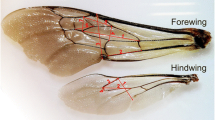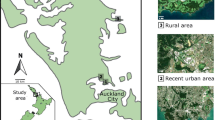Abstract
Colonization of urban habitats requires physiological, behavioral and morphological changes in many species. This is well studied in the Common Blackbird (Turdus merula), one of the most common bird species in Europe. Former studies found that urban Blackbirds show decreased migratory behavior. However, it is still a matter of debate whether this is linked to morphological changes. According to Seebohm’s rule, sedentary individuals have less pointed wings in contrast to migratory individuals. Here we assess if wing pointedness—as measured by Kipp’s index—decreases along a rural to urban gradient in Blackbirds. To determine this, Blackbirds were caught in Frankfurt am Main and Heidelberg, as well as in the neighboring uplands of the Taunus and Odenwald, along a virtual continuous urbanization gradient, ranging from nearby forests to city centers. Along this gradient, wing pointedness significantly decreased in male, but not in female, Blackbirds. However, this trend was no longer significant when considering single regions. This indicates that wing pointedness does not change uniformly across the species’ range because of different intensities of urbanization. Sex-specific differences might be due to distinct territorial and dominance behavior. Variations in wing shape of urban and rural Blackbird populations are most likely based on a combination of better climatic conditions and increased food availability, as well as behavior adjusted to urban habitats. This study shows urbanization effects on the wing morphology of Blackbirds that might coincide with reduced migratory behavior.
Zusammenfassung
Beeinflusst die Urbanisierung die Flügelspitzigkeit bei der Amsel Turdus merula ?
Die Besiedlung urbaner Lebensräume erfordert bei vielen Arten Veränderungen in Physiologie, Verhalten und Morphologie. Dies ist bei der Amsel (Turdus merula) gut untersucht, einer der häufigsten Vogelarten in Europa. Frühere Studien fanden heraus, dass Stadt-Amseln ein reduziertes Zugverhalten zeigen. Allerdings ist es immer noch umstritten, ob dies mit morphologischen Veränderungen einhergeht. Nach Seebohm’s Regel besitzen nicht-ziehende Individuen weniger spitze Flügel als ziehende Individuen. In dieser Studie untersuchten wir, ob die Flügelspitzigkeit—basierend auf dem Kipp-Index—bei Amseln entlang eines Land-Stadt-Gradienten abnimmt. Um dies festzustellen, wurden Amseln in Frankfurt am Main und Heidelberg sowie in den angrenzenden Mittelgebirgen Taunus und Odenwald gefangen, und zwar entlang eines virtuellen kontinuierlichen Urbanisierungsgradienten, der von nahegelegenen Wäldern bis in die Innenstädte hineinreicht. Entlang dieses Gradienten nahm die Flügelspitzigkeit bei männlichen, aber nicht bei weiblichen Amseln signifikant ab. Dieser Trend ist jedoch nicht mehr signifikant, wenn die Regionen separat betrachtet werden. Das bedeutet, dass sich die Flügelspitzigkeit aufgrund unterschiedlicher Urbanisierungsintensitäten nicht einheitlich über das Artareal hinweg ändert. Geschlechterspezifische Unterschiede gehen möglicherweise auf unterschiedliches Territorial- und Dominanzverhalten zurück. Variationen in der Flügelform von Stadt- und Landpopulationen der Amsel basieren höchstwahrscheinlich auf einer Kombination von besseren klimatischen Bedingungen und höherer Nahrungsverfügbarkeit sowie an städtische Habitate angepasstem Verhalten. Diese Studie zeigt Auswirkungen der Verstädterung auf die Flügelmorphologie von Amseln, die möglicherweise mit reduziertem Zugverhalten in Zusammenhang stehen.


Similar content being viewed by others
References
Alberti M (2005) The effects of urban patterns on ecosystem function. Int Regional Sci Rev 28(2):168–192. https://doi.org/10.1177/0160017605275160
Baldwin MW, Winkler H, Organ CL, Helm B (2010) Wing pointedness associated with migratory distance in common-garden and comparative studies of Stonechats (Saxicola torquata). J Evol Biol 23:1050–1063. https://doi.org/10.1111/j.1420-9101.2010.01975.x
Batten LA (1973) Population dynamics of suburban Blackbirds. Bird Study 20(4):251–258. https://doi.org/10.1080/00063657309476389
Berthold P (1996) Control of bird migration. Chapman and Hall, London
Bitton P-P, Graham BA (2015) Change in wing morphology of the European Starling during and after colonization of North America. J Zool 295(4):254–260. https://doi.org/10.1111/jzo.12200
Chace JF, Walsh JJ (2006) Urban effects on native avifauna: a review. Landsc Urban Plan 74(1):46–69. https://doi.org/10.1016/j.landurbplan.2004.08.007
Chamberlain DE, Cannon AR, Toms MP, Leech DI, Hatchwell BJ, Gaston KJ (2009) Avian productivity in urban landscapes: a review and meta-analysis. Ibis 151:1–18
Climate Data (2012) Klima: Deutschland. http://de.climate-data.org/country/232/. Accessed 22 July 2016
Desrochers A (2010) Morphological response of songbirds to 100 years of landscape change in North America. Ecology 91(6):1577–1582
Ditchkoff SS, Saalfeld ST, Gibson CJ (2006) Animal behavior in urban ecosystems: modifications due to human-induced stress. Urban Ecosyst 9:5–12. https://doi.org/10.1007/s11252-006-3262-3
Dulisz B, Nowakowski JJ, Górnik J (2016) Differences in biometry and body condition of the House Sparrow (Passer domesticus) in urban and rural population during breeding season. Urban Ecosyst 19:1307–1324. https://doi.org/10.1007/s11252-016-0546-0
Eck S, Fiebig J, Fiedler W, Heynen I, Nicolai B, Töpfer T, van den Elzen R, Winkler R, Woog F (2011) Measuring birds = Vögel vermessen. Christ Media Natur, Minden
Egbert JR, Belthoff JR (2003) Wing shape in House Finches differs relative to migratory habit in eastern and western North America. Condor 105(4):825–829
Evans KL, Gaston KJ, Frantz AC, Simeoni M, Sharp SP, McGowan A, Dawson DA, Walasz K, Partecke J, Burke T, Hatchwell BJ (2009a) Independent colonization of multiple urban centres by a formerly forest specialist bird species. Proc R Soc B 276:2403–2410. https://doi.org/10.1098/rspb.2008.1712
Evans KL, Gaston KJ, Sharp SP, McGowan A, Hatchwell BJ (2009b) The effect of urbanisation on avian morphology and latitudinal gradients in body size. Oikos 118:251–259. https://doi.org/10.1111/j.1600-0706.2008.17092.x
Evans J, Boudreau K, Hyman J (2010a) Behavioural syndromes in urban and rural populations of Song Sparrows. Ethology 116:588–595. https://doi.org/10.1111/j.1439-0310.2010.01771.x
Evans KL, Hatchwell BJ, Parnell M, Gaston KJ (2010b) A conceptual framework for the colonisation of urban areas: the Blackbird Turdus merula as a case study. Biol Rev 85:643–667. https://doi.org/10.1111/j.1469-185X.2010.00121.x
Evans KL, Newton J, Gaston KJ, Sharp SP, McGowan A, Hatchwell BJ (2012) Colonisation of urban environments is associated with reduced migratory behaviour, facilitating divergence from ancestral populations. Oikos 121:634–640. https://doi.org/10.1111/j.1600-0706.2011.19722.x
Falk JH (1976) Energetics of a suburban lawn ecosystem. Ecology 57(1):141–150
Fernández-Juricic E, Blumstein DT, Abrica G, Manriquez L, Adams LB, Adams R, Daneshrad M, Rodriguez-Prieto I (2006) Relationships of anti-predator escape and post-escape responses with body mass and morphology: a comparative avian study. Evol Ecol Res 8:731–752
Flinks H, Salewski V (2012) Quantifying the effect of feather abrasion on wing and tail lengths measurements. J Ornithol 153:1053–1065. https://doi.org/10.1007/s10336-012-0834-2
Francis RA, Chadwick MA (2012) What makes a species synurbic? Appl Geogr 32:514–521. https://doi.org/10.1016/j.apgeog.2011.06.013
Francis CD, Ortega CP, Cruz A (2011) Noise pollution filters bird communities based on vocal frequency. PLoS One 6(11):e27052. https://doi.org/10.1371/journal.pone.0027052
Fudickar AM, Partecke J (2012) The flight apparatus of migratory and sedentary individuals of a partially migratory songbird species. PLoS One 7(12):e51920. https://doi.org/10.1371/journal.pone.0051920
Fudickar AM, Schmidt A, Hau M, Quetting M, Partecke J (2013) Female-biased obligate strategies in a partially migratory population. J Anim Ecol 82:863–871. https://doi.org/10.1111/1365-2656.12052
HLNUG (2016) Hessisches Landesamt für Naturschutz, Umwelt und Geologie: recherche. http://www.hlnug.de/messwerte/luft/recherche.html. Accessed 12 October 2016
Kark S, Iwaniuk A, Schalimtzek A, Banker E (2007) Living in the city: can anyone become an ‘urban exploiter’? J Biogeogr 34:638–651. https://doi.org/10.1111/j.1365-2699.2006.01638.x
Liker A, Papp Z, Bókony V, Lendvai ÁZ (2008) Lean birds in the city: body size and condition of House Sparrows along the urbanization gradient. J Anim Ecol 77:789–795. https://doi.org/10.1111/j.1365-2656.2008.01402.x
Lundberg P (1985) Dominance behaviour, body weight and fat variations, and partial migration in European Blackbirds Turdus merula. Behav Ecol Sociobiol 17:185–189
Luniak M (1990) Avifauna of cities in central and eastern Europe: results of the international inquiry. In: Luniak M (ed) Urban ecological studies in central and eastern Europe. Ossolineum, Wroclaw, pp 131–149
Luniak M, Mulsow R, Walasz K (1990) Urbanization of European Blackbird: expansion and adaptations of urban population. In: Luniak M (ed) Urban ecological studies in central and eastern Europe. Ossolineum, Wroclaw, pp 187–198
Møller AP (2008) Flight distance of urban birds, predation, and selection for urban life. Behav Ecol Sociobiol 63:63–75. https://doi.org/10.1007/s00265-008-0636-y
Mueller JC, Partecke J, Hatchwell BJ, Gaston KJ, Evans KL (2013) Candidate gene polymorphisms for behavioural adaptations during urbanization in Blackbirds. Mol Ecol 22:3629–3637. https://doi.org/10.1111/mec.12288
Oke TR (1973) City size and the urban heat island. Atmos Environ 7:769–779
Ökoplana, GEO-NET (2015) Stadtklimagutachten für die Stadt Heidelberg. Fortschreibung des Gutachtens von 1995. Hannover
Partecke J, Gwinner E (2007) Increased sedentariness in European Blackbirds following urbanization: a consequence of local adaption? Ecology 88(4):882–890
Partecke J, Gwinner E, Bensch S (2006a) Is urbanisation of European Blackbirds (Turdus merula) associated with genetic differentiation? J Ornithol 147(4):549–552. https://doi.org/10.1007/s10336-006-0078-0
Partecke J, Schwabl I, Gwinner E (2006b) Stress and the city: urbanization and its effects on the stress physiology in European Blackbirds. Ecology 87(8):1945–1952
R Development Core Team (2015) R: a language and environment for statistical computing. R Foundation for Statistical Computing, Wien, Austria. https://www.r-project.org/
Ruiz G, Rosenmann M, Novoa FF, Sabat P (2002) Hematological parameters and stress index in Rufous-collared Sparrows dwelling in urban environments. Condor 104:162–166
Salewski V, Siebenrock K-H, Hochachka WM, Woog F, Fiedler W (2014) Morphological change to birds over 120 years is not explained by thermal adaptation to climate change. PLoS One 9(7):e101927. https://doi.org/10.1371/journal.pone.0101927
Schwabl H (1983) Ausprägung und Bedeutung des Teilzugverhaltens einer südwestdeutschen Population der Amsel Turdus merula. J Ornithol 124(2):101–116
Seebohm H (1901) The birds of Siberia: a record of a naturalist’s visits to the valleys of the Petchora and Yenesei. Murray, London
Seress G, Lipovits Á, Bókony V, Czúni L (2014) Quantifying the urban gradient: a practical method for broad measurements. Landsc Urban Plan 131:42–50. https://doi.org/10.1016/j.landurbplan.2014.07.010
Slabbekoorn H, den Boer-Visser A (2006) Cities change the songs of birds. Curr Biol 16:2326–2331. https://doi.org/10.1016/j.cub.2006.10.008
Statistik Hessen (2016) Bevölkerungsstand. https://statistik.hessen.de/zahlen-fakten/bevoelkerung-gebiet-haushalte. Accessed 22 July 2016
Statistisches Landesamt Baden-Württemberg (2016) Bevölkerung im Überblick. http://www.statistik-bw.de/BevoelkGebiet/Bevoelkerung/. Accessed 22 July 2016
Török J, Ludvig E (1988) Seasonal changes in foraging strategies of nesting Blackbirds (Turdus merula L.). Behav Ecol Sociobiol 22:329–333
van Vliet J, Musters C, Ter Keurs WJ (2009) Changes in migration behaviour of Blackbirds Turdus merula from the Netherlands. Bird Study 56(2):276–281. https://doi.org/10.1080/00063650902792148
Vanhooydonk B, Herrel A, Gabela A, Podos J (2009) Wing shape variation in the Medium Ground Finch (Geospiza fortis): an ecomorphological approach. Biol J Linn Soc 98:129–138
Yom-Tov Y, Yom-Tov S, Wright J, Thorne CJR, Du Feu R (2006) Recent changes in body weight and wing length among some British passerine birds. Oikos 112:91–101
Zhang K, Wang R, Shen C, Da L (2010) Temporal and spatial characteristics of the urban heat island during rapid urbanization in Shanghai, China. Environ Monit Assess 169:101–112. https://doi.org/10.1007/s10661-009-1154-8
Acknowledgments
We thank the regional authority for bird conservation, the Staatliche Vogelschutzwarte für Hessen, Rheinland-Pfalz und Saarland, for a great deal of support, and other local as well as regional authorities for research permits. Franziska Beedgen, Franzisca Haffner, Rolf Hennes, Sabrina Hoffmann, Hans Koller, Liviu Pârâu, Lisa Söhn, Hedwig Sauer-Gürth, Sven Klimpel, Kristin Stützel, Rebekka Tietze, Olga Tzortzakaki, and Michael Wink helped invaluably with fieldwork and logistics. Comments from three reviewers greatly improved the original manuscript. The experiments comply with the current laws of the country in which they were performed.
Author information
Authors and Affiliations
Corresponding author
Additional information
Communicated by F. Bairlein.
Electronic supplementary material
Below is the link to the electronic supplementary material.
Rights and permissions
About this article
Cite this article
Saccavino, E., Krämer, J., Klaus, S. et al. Does urbanization affect wing pointedness in the Blackbird Turdus merula?. J Ornithol 159, 1043–1051 (2018). https://doi.org/10.1007/s10336-018-1575-7
Received:
Revised:
Accepted:
Published:
Issue Date:
DOI: https://doi.org/10.1007/s10336-018-1575-7




